Introduction
This study is based on four registers kept in the Archivio di Stato di Arezzo, ASAr. Some research I have already carried out there, as reported in a previous note, to which I can refer for information on the archive.(1)
As it is becoming usual in Florence and other towns of Tuscany, in my research on the history of playing cards – mainly focused on the 15th century - I am including times nearer to us, reporting and discussing documents of the following centuries as well. In the present note, I examine the cards used in Arezzo by players, who gathered at Accademia dei Costanti in the 19th century.
The Accademia dei Costanti in Arezzo
As in other towns, there existed in Arezzo a house in which the nobles could gather for parties, dances, pastimes, and any social event: its name was Casino dei Nobili, and, according to the designation itself, the attendance was strictly reserved to people who could prove their belonging to the noble families of the town. This activity began in the late 17th century and included the organisation of performances and the control of one or more theatres.
In 1804, another society was established, with the aim to allow the participation in social events to citizens, who were not admitted to Casino dei Nobili. It could not be expected at the time that even this more popular club was open to everybody: it was mainly the educated middle classes who could profit of the new institution; some noblemen took part as well.
This society evolved in 1824 into a veritable Accademia. This title was of course of a honorific kind, reminding prestigious companies that so much value had added in the previous centuries to philosophy, poetry, and human arts in general. At the time, however, the term was simply applied to companies of fellows, who were just organising events and everyday social gatherings and play, at the town level.
The location, acquired by the Accademia, was a prestigious one, Palazzo Lambardi, just in front of the church of San Francesco, still visited by many tourists, especially for enjoying the wonderful frescoes by Piero della Francesca. In particular, the Caffé dei Costanti, which had begun its activity in the palace before the foundation of the Accademia, is even now open in the same place.
We have suitable information on this particular Accademia; (2) the article indicated covers all the time interval of its activity, namely from 1804 to 1872. However, the documents that I am using only belong to a small part of that interval.
The four registers under examination
Within the documents of the Costanti, a series of four registers is particularly interesting for the practice of card playing by members and visitors accepted. In particular, we find there the amounts of card packs purchased, and also of used packs that could be sold back as such.
The series is clearly far from complete, only covering a few years, as indicated in the following table.
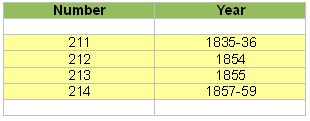
The first register has a few lists of purchases, with only six pages written. The contents of pages 1 and 3 are summarised in the following table.
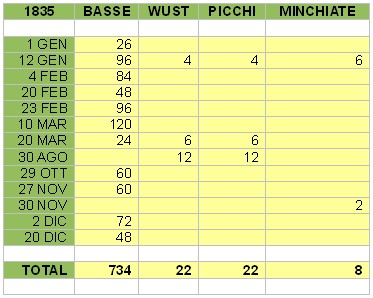
It is clear that at the time Carte Basse were by far the most employed. I am not certain of the reading Wust, which plausibly corresponded to whist, or 52-card packs. Picchi on the other hand is clearly written, but it is not warranted that these were 32-card packs. Only eight packs of Minchiate per year were not many, corresponding to just one per cent of the total. On pages 2 and 4 we find lists of playing cards sold back to different purchasers; the total for the year is 700 packs of Basse and a dozen Minchiate.
In the following two pages we find some records for the following year, 1836. This appears only to correspond to a partial presentation. What is clear is that essentially Carte Basse were purchased, 11, 12 and 8 dozens in March, May and August respectively; as supplier we find the Florentine cardmaker Falugi. There is an entry for February corresponding to 521 Basse, 16 Wust, 16 Picchi and 12 Minchiate, but this may correspond to the packs available in the Accademia, and not to purchases of that month.
For the years from 1836 to 1853 we find no registers, but with the end of 1853 the records appear again, in correspondence with a reopening of the Accademia. The situation of the profit and loss account had never been brilliant for the Costanti, but in the last years the academics had reduced to just thirteen, instead of the thirty-six required by the statute.
In 1853, the Accademia was closed for several months for necessary works of repairs. With the entry of twenty-two new members the renovated location was reopened on 28 December 1853, and the activity could be resumed with some success. In 1856, a reading room was opened too, with an adequate supply of newspapers and journals.
For these years, the three remaining registers of the group kept in the ASAr are more uniform and regularly compiled. The pages are cut at the top, so that the text written on top of the inside cover is used as heading for all the inner pages, structured as a series of columns of numbers.
Let us examine the succession of these columns. The first column is dedicated to the date of each record, with all the entries inserted in chronological order. Then we have two columns for oil, amount and cost - this was clearly needed for lighting.
Many columns follow, precisely for playing cards. We find four subsequent groups of three columns: cards acquired, given to the director, received from the director, sold back. Each group is formed by three columns, according to the kind of cards involved: 40-card packs, 32 and/or 52-card packs, Minchiate. The three columns used for cards sold back are instead dedicated to 40-card, Minchiate, and money obtained.
Two further columns contain sales of stearin scraps. Finally we find two larger columns for expenses, minor and extraordinary respectively.
If we limit our attention to the columns of card amounts, the contents can be summarised as in the following table.
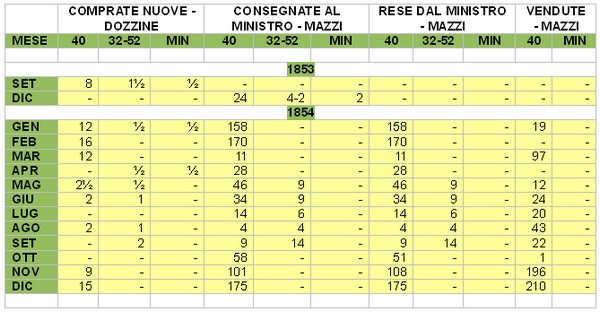
The new cards acquired are recorded as dozens in the first three columns, whereas individual packs are indicated in the following columns. The absolute preponderance of the 40-card packs is evident.
The eighteen packs of Minchiate, which we see acquired in the years 1853-54, are the last cards of that kind purchased for the Accademia. In the registers of the following years the entries are less regularly recorded, but any purchase of Minchiate is certainly no longer present there.
This is probably the most interesting information of them all, because it allows us to determine the end of the practice of the most typical Florentine game by the Costanti, which plausibly corresponded to the end of Minchiate playing for Arezzo in general.
It is not easy to judge whether this date is early or late – in several other towns of Tuscany the game had been barely played even in previous centuries. In Lucca, for instance, we can verify that Minchiate were not produced any longer in the years 1810-11. (3)
The most significant comparison is certainly with Florence itself. It is not easy for Florence to fix the complete interruption of Minchiate playing. However, the production of Minchiate packs by the local cardmakers decreased from about ten per cent in the beginning of the 19th century down to less than one per cent in 1861. When Florence became the capital town of Italy, in 1865, the new habits introduced by the new rulers, officers, and civic servants, contributed to the death of a game that was practically already dead.
The comparison with Florence can thus be taken as a support for understanding the date for Arezzo as a late one – as a proof, in other words, that the game of Minchiate kept there its supporters as long as possible.
Conclusion
Four registers of the Accademia dei Costanti, active in Arezzo, have been kept in the local Archivio di Stato; they contain, among other information, records of expenses for playing cards in the years 1835-36 and 1853-59.
The complete set of card amounts involved allows us to have a look on the favourite card games of Arezzo citizens. Of course, the most used was the common 40-card pack, with which popular games could be played, to begin with those of the Tressette family.
Interesting is the presence of Minchiate among the cards acquired, confirming the endurance of their old tradition among local players. This lasted up to 1854 – in the following years we find no trace of Minchiate any longer. On the other hand, we know that, in the same years, the typical Florentine game of Minchiate was rapidly losing its popularity in Florence itself.
Footnotes:
(1) Franco Pratesi: Around 1450 – some Official Documents for Arezzo, (2012)
(2) Raissa Athena Lisi, “L'Accademia dei Costanti dal 1804 al 1872”. Notizie storiche della Società storica aretina, Vol. 17 (2007) 18-21, 27.
(3) Franco Pratesi: 1810-1811 – Playing Cards in Lucca, (2013)
|
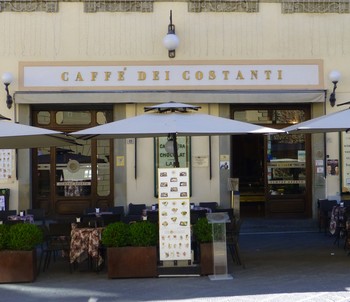
Caffé dei Costanti
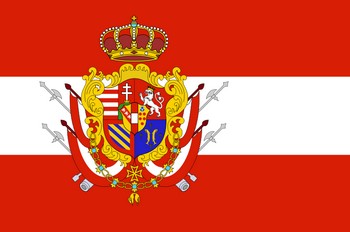
Flag of Tuscany
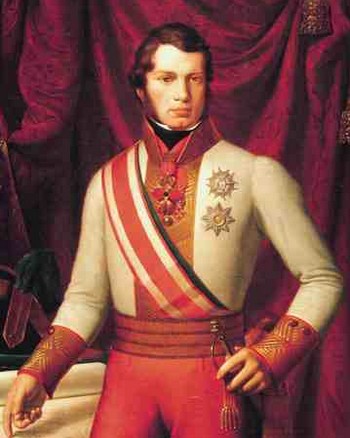
Leopold II, Grand Duke of Tuscany
(reigned 1824-1859)
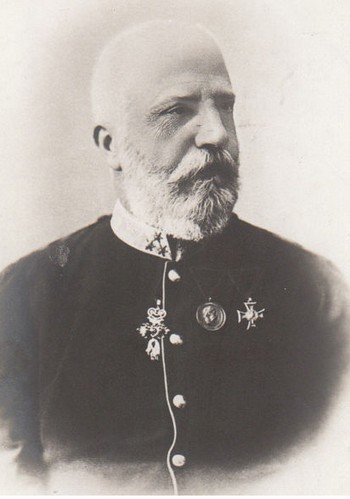
Ferdinand IV, last Grand Duke of Tuscany
(reigned 1859-60)
Ferdinand (24 years old in 1859) "and his family were forced to flee Florence on April 27, 1859, with the outbreak of a revolution inspired by the outbreak of a war by France and Sardinia-Piedmont against Austria as part of the unification of Italy. The family took refuge in Austria. After the end of the war, Leopold II abdicated on July 21, and Ferdinand succeeded him as Grand Duke. Ferdinand proved unable to return to Florence to claim his throne, and an elected Tuscan National Assembly formally deposed him only a month later, on August 16. Ferdinand still hoped to recover his throne, as both France and Austria had promised to recognize his rights to it in the Armistice of Villafranca. However, neither power was willing to take any steps to bring about his restoration. The Kingdom of Sardinia annexed Tuscany on March 22, 1860, ending Ferdinand's hopes to reclaim the throne." (wiki)
|
|







